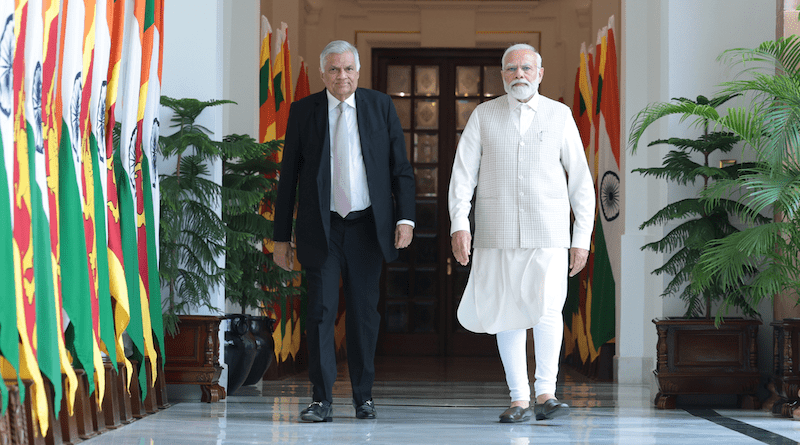Ranil Wickremesinghe’s India Visit: Key Bilateral Commitments And Challenges – Analysis
By Institute of South Asian Studies
By Pradeep Ranaweera and Rajni Gamage
In July 2023, Sri Lanka’s President Ranil Wickremesinghe made his first official visit to India. The visit was significant, given the economic crisis which engulfed Sri Lanka last year. Sri Lanka was forced to declare bankruptcy due to a critical shortage in foreign reserves. The resulting social and political unrest threatened regional stability.
India provided Sri Lanka with economic and humanitarian assistance of over US$4 billion (S$5.3 billion) in the context of the crisis last year. India was also Sri Lanka’s first bilateral creditor and extended a letter of support towards Sri Lanka’s debt restructuring efforts. This was critical in Sri Lanka securing a US$3.2 billion (S$4.2 billion) bailout from the International Monetary Fund (IMF). Discussions on making the Indian rupee available for use in Sri Lanka are ongoing.
Promoting and Strengthening Connectivity
During the bilateral discussions, the importance of strengthening connectivity in the following areas was emphasised:
- Maritime connectivity: To enhance cooperation in the development of ports and logistics infrastructure at Colombo, Trincomalee and Kankesanthurai;
- Air connectivity: To resume flights between Jaffna and Chennai;
- Energy and power connectivity: To conclude a memorandum of understanding on cooperation in developing renewable energy potential, and establish a high-capacity power grid interconnection between India and Sri Lanka;
- Trade, economic and financial connectivity: To facilitate Indian investments in the divestment of Sri Lankan state-owned enterprises and in economic zones in Sri Lanka, undertake discussions on the Economic and Technology Cooperation Agreement, and reaffirm the decision to designate INR as currency for trade;
- People-to-people connectivity: To establish land connectivity between Sri Lanka and India.
Challenges to Bilateral Relations
Despite commitments to stronger engagement, bilateral relations between Colombo and New Delhi are challenged by three main factors.
First, the Indian central government faces political pressure from the Tamil Nadu state government to provide a solution to Sri Lankan Tamil demands for rights and autonomy. The ruling Bharatiya Janata Party (BJP) is relatively less popular in the southern Indian states and several opposition parties recently formed an ‘India’ alliance to challenge the BJP. Wickremesinghe’s promise of a full implementation of the 13th Amendment, minus police powers and the Truth and Reconciliation Commission, is primarily driven by the Indian side.
However, the Sri Lankan president faces several political challenges in implementing the 13th Amendment. He is attempting to offload this politically expensive move to the Parliament by calling for an all-party conference on the national reconciliation issue. The Tamil National Alliance has “categorically rejected” the offer to implement the 13th Amendment sans police powers, calling it another “hollow promise”. Two key opposition parties – Samagi Jana Balawegaya and National People’s Power – have refused to attend the all-party conference. Clear divisions between the pro-devolution and nationalist camps in parliament are also evident. The leader of the Sinhala Buddhist nationalist party, Pivithuru Hela Urumaya, Minister of Parliament Udaya Gammanpila, has said he will bring forward a 22nd Amendment to the Constitution to repeal police powers from the 13th Amendment.
Second, Sri Lanka must manage Indian insecurity over China’s growing influence in the Indian Ocean region. It has been customary for a new Sri Lankan president to make his first official visit to India. This reaffirms the key role that India has in Sri Lanka’s foreign policy. However, since assuming office in July 2022, Wickremesinghe has visited nine other countries before his official trip to India. Notable among these visits are the United Kingdom, France, Japan and Singapore. This shift reflects the urgency with which the political leadership has had to generate consensus among key bilateral creditors on its foreign debt restructuring. In early 2023, the Sri Lankan president received assurances on debt restructuring from the Export-Import Bank of China, which was crucial to secure an IMF bailout package.
Finally, there is growing opposition amongst the domestic groups in Sri Lanka in response to bilateral issues. In early 2023, Sri Lanka’s northern fishermen protested strongly against the government’s plan to issue licences to Indian fishermen entering Sri Lankan waters. Despite the long-standing nature of the fisheries conflict, this issue was not raised in the recent bilateral discussions.
In June 2022, an Adani project in Sri Lanka was at the centre of domestic controversy after a government official told a parliamentary panel that a renewable energy project in Mannar was given to the Adani Group after Indian Prime Minister Narendra Modi “pressured” then president, Gotabaya Rajapaksa. During the recent official visit, it was confirmed that the Adani Group’s renewable energy project in Mannar would be completed by 2025.
The visit by Wickremesinghe to India was important and opportune, with both sides agreeing to collaborate in a number of areas. However, several developments, particularly in Sri Lanka, point to challenges confronting the two government. While bilateral ties have improved in recent times, efforts to address the key challenges will further bolster ties between the two neighbours.
About the authors:
- Mr Pradeep Ranaweera is an Academic Instructor at the Department of Strategic Studies at General Sir John Kotelawala Defence University, Sri Lanka. He can be contacted at [email protected].
- Dr Rajni Gamage is a Postdoctoral Fellow at the Institute of South Asian Studies (ISAS), an autonomous research institute at the National University of Singapore (NUS). She can be contacted at [email protected]. The authors bear full responsibility for the facts cited and opinions expressed in this paper.
Source: This article was published by the Institute of South Asian Studies

